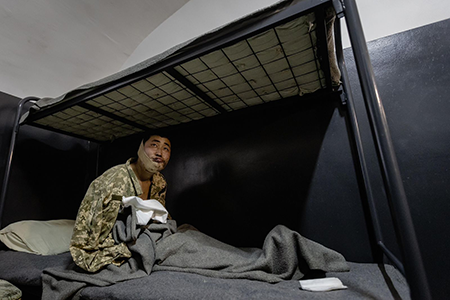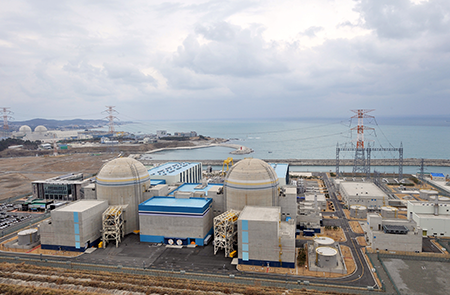"I want to tell you that your fact sheet on the [Missile Technology Control Regime] is very well done and useful for me when I have to speak on MTCR issues."
How Trump’s Turn Toward Putin Could Shake Up Asia
May 2025
By Toby Dalton
The about-face on Russia by U.S. President Donald Trump’s administration, amplified by its sharp criticism of the United States’ European allies and apparent abandonment of Ukraine, is scrambling the security order in Europe. Yet, the broader significance of Trump’s embrace of Russian President Vladimir Putin and shift away from enduring interest-based alliances is that these moves also could portend considerable disruption in Asia. Some of that disruption might be positive, for example if it leads to arms control talks with China or a nuclear restraint agreement with North Korea. Yet, it also could drive South Korea or Japan to acquire nuclear weapons if they feel abandoned by the United States.
Russia vs. China

Trump’s shift toward Russia reads like a classic great-power politics gambit: an attempt to ameliorate conflict between Washington and Moscow that otherwise keeps the United States tied to Europe, and to woo Russia over to the U.S. side against China.
The biggest unknown is whether Putin sees the situation reciprocally. In recent years, Russia pursued a comprehensive strategic relationship with China, what the two countries have labeled a “no limits” partnership.1 In the three years since Russia’s full-scale invasion of Ukraine, Beijing and Moscow have deepened their military ties and now regularly conduct combined exercises. China has been a steadfast although primarily rhetorical supporter of Russia’s war in Ukraine, and the two countries are aligned in challenging or subverting a U.S.-led international order. Broadly, the ideological divisions and divergent interests that contributed to the Sino-Soviet split in the 1960s are not present today and it seems doubtful that the United States could easily drive China and Russia apart.
If creating a wedge between China and Russia proves impossible, Trump may instead seek Putin’s help to engage Chinese President Xi Jinping in nuclear talks. Although perhaps not as strong as his obsession with striking a nuclear deal with North Korea, Trump periodically floats the idea of China joining Russia-U.S. nuclear arms control negotiations. He stated March 6, “I was very close to having a program with Russia—denuclearization—and we were going to get China; I spoke with President Xi about it, and he would have been very happy to go along with it.… But I would very much like to start those talks … the denuclearization would be incredible.”2
Despite Trump’s bromides, China’s consistent position on joining arms control negotiations effectively can be summarized as “No thanks; you first make deeper cuts and then we might consider it.”3 Yet, a Russia-U.S. rapprochement that facilitates a successor to the New Strategic Arms Reduction Treaty eventually could enable three-way talks with China. Although it is difficult today to imagine such an agreement to limit or even reduce nuclear arms, there are many other avenues for reducing the chances of nuclear use that would be beneficial for U.S. and global security.
Russia, North Korea, and Nuclear Talks
To help prosecute its war in Ukraine, Russia revamped its military relationships with North Korea and Iran. Initially, this involved buying Iranian-made kamikaze drones and North Korean artillery shells. Later, North Korea provided short-range ballistic missiles and even 11,000 soldiers to fight directly alongside Russian forces seeking to expel Ukrainian forces from occupied territory in Russia’s Kursk region. North Korea and Russia signed a new mutual defense pact in June 2024.

The quid pro quos for this military assistance to Russia are not fully clear, although Russia promised to cooperate on space and peaceful nuclear energy with North Korea as part of upgraded military ties. More broadly, analysts have interpreted Russia’s embrace of both countries—North Korea has tested a nuclear weapon and Iran is moving closer to being able to produce a bomb—as indicating abandonment of nonproliferation as a long-standing strategic priority. U.S. officials warned in December 2024, for example, that “Russia may be close to accepting North Korea’s nuclear weapons program, reversing Moscow’s decades-long commitment to denuclearize the Korean peninsula.”4
How Russia treats these partnerships in the future could be a critical factor as Trump seeks to forge a broader rapprochement with Putin, and also to constrain the nuclear programs of Iran and North Korea. Does Putin see them as transient relationships of convenience in the context of Ukraine or as building blocks of Russia’s effort to reconstitute its global power?
To that point, in a March 18 telephone call that raised more questions than answers, Trump and Putin reportedly agreed on “the need to stop proliferation of strategic weapons and [to] engage with others to ensure the broadest possible application.”5
North Korea poses the most challenging issues in this regard. Trump regularly expresses interest in rekindling efforts to reach a nuclear deal with North Korean leader Kim Jong Un, as he did March 13, saying, “I have a great relationship with Kim Jong Un, and we’ll see what happens, but certainly he’s a nuclear power.”6 North Korea’s nuclear weapons arsenal has indeed grown in number and sophistication since Trump failed to close a restraint agreement with Kim during their summit diplomacy in 2018-2019. These advanced North Korean capabilities are among the drivers of South Korean interest in nuclear weapons, so a restraint agreement with Pyongyang could also dampen nuclear clambering in Seoul.
As with Xi, Putin might be tempted to parlay Trump’s desire for a nuclear deal with Kim for a seat at the negotiating table and influence on the outcome. Undoubtedly, Putin would want to ensure that any North Korean-U.S. engagement does not compromise Russian interests, but he also may calculate that helping Trump could yield dividends elsewhere.
Conversely, North Korea may be perceived in Russia as a useful thorn in the side of the United States and its Asian allies. Russian national security expert Dmitry Trenin argued in 2023, for example, that, “destabilization of the [nuclear Nonproliferation Treaty] is an important factor undermining American hegemony.… [T]he DPRK and Iran are political opponents of the United States and at the same time increasingly close partners of Russia. It is unthinkable to cooperate with Washington, which is waging a war with Russia by the hands of Ukrainians, against Iran and the DPRK, which somehow help [sic] us in this war.”7
Impact on Japan and South Korea
Thus far, Japan and South Korea have been spared the ire of Trump administration officials, who mainly have criticized European governments for various perceived offenses. But Seoul and Tokyo no doubt are discomfited by Trump’s intimations that he may not feel bound by long-standing U.S. security guarantees. During the 2024 presidential campaign, for instance, Trump famously recounted a conversation with a foreign head of government in which he said he “would not protect you. In fact, I would encourage [Russia] to do whatever the hell they want. You gotta pay.”8 In this regard, Trump’s abusive abandonment of Ukraine could spur additional efforts to augment security capabilities, including consideration of nuclear weapons, among U.S. Asian allies. South Koreans, in particular, have long harbored fear about U.S. abandonment dating to the 1949 withdrawal of U.S. military personnel, followed shortly thereafter by the North Korean invasion that catalyzed the 1950-1953 Korean War.

In Seoul, there has been growing interest in and public support for nuclear weapons for over a decade, well before Trump was even a likely political candidate. South Korean political conservatives are the most vocal champions of a domestic nuclear weapons program, but Trump’s behavior may give progressives reason to reconsider their skepticism. For now, there is a growing movement for nuclear “latency” (called the Mugunghwa Forum), whereby South Korea would accumulate the additional capabilities necessary for producing nuclear weapons should it decide to build them in the future.9
Nuclear latency advocates are urging the South Korean government to negotiate with the United States for permission to develop uranium enrichment and plutonium reprocessing capabilities, first by upgrading the existing South Korean-U.S. nuclear cooperation agreement. This is highly likely to be a key item on Seoul’s wish list as South Korean and U.S. officials sort through alliance, security, and trade issues.
The real wild card pertains to the Trump administration’s intentions regarding the U.S. defense posture and extended deterrence commitments. If Trump seeks to withdraw U.S. forces stationed on the Korean peninsula, then South Korean leaders might feel forced to proceed with a nuclear weapons effort, despite the challenges they would likely encounter.
Japan in many ways occupies a more difficult position: With a capable but constrained self-defense force, it is more reliant on U.S. extended deterrence despite its security and territorial issues with China, North Korea, and Russia. Tokyo has fewer immediate options to remedy U.S. retrenchment, apart from building nuclear weapons, which it likely could achieve faster than South Korea but which would be far more politically complicated given the strong Japanese pro-disarmament movement. Tokyo seems likely to continue efforts to stay out of Trump’s firing line and not give him any reason to consider abandonment.
As the implications of Trump’s shift toward Russia become clear, the potential effects in Asia seem likely to boil down to the issue of linkage. In the past, Russia has proved willing to use its influence to further nonproliferation goals, as it did during negotiations with Iran leading to the 2015 nuclear agreement. However, if transactional politics dominate in the absence of a broader Russian-U.S. strategic alignment, Moscow will be less willing to use its influence with China or North Korea in ways that could benefit the United States.10 At least, not without extracting a price. Whether that price includes a reduction in the U.S. defense posture in Asia, negotiated without the input of U.S. allies, will be a critical determinant of the future number of nuclear-armed states in the region.
ENDNOTES
1. “Joint Statement of the Russian Federation and the People’s Republic of China on the International Relations Entering a New Era and the Global Sustainable Development,” President of Russia, February 4, 2022.
2. @RapidResponse47, Remarks by U.S. President Donald Trump, X, March 6, 2025, 3:13 PM.
3. “Foreign Ministry Spokesperson Guo Jiakun’s Regular Press Conference on February 14, 2025,” Ministry of Foreign Affairs of the People’s Republic of China, February 14, 2025.
4. “Remarks by Ambassador Linda Thomas-Greenfield at a UN Security Council Briefing on Nonproliferation and the Democratic People’s Republic of Korea,” United States Mission to the United Nations, December 18, 2024.
5. White House Press Secretary Karoline Leavitt, “President Donald J. Trump’s Call with President Vladimir Putin,” U.S. Embassy & Consulates in Russia, March 18, 2025.
6. “Trump says he still has good relations with leader of ‘nuclear power’ North Korea,” Reuters, March 13, 2025.
7. Dmitry Trenin, “On a New Global Order and Its Nuclear Dimension. An Interview,” PIR Center, 2023, No. 2: 36, 2023.
8. Jill Colvin, “Trump says he once told a NATO ally to pay its share or he’d ‘encourage’ Russia to do what it wanted,” Associated Press, February 11, 2024.
9. Lami Kim, “South Korea’s Nuclear Latency Dilemma,” War on the Rocks, September 19, 2024.
10. Keith Bradsher and Berry Wang, “China Backs Iran in Nuclear Talks, Slams ‘Threat of Force’ From the West,” The New York Times, March 14, 2025.
